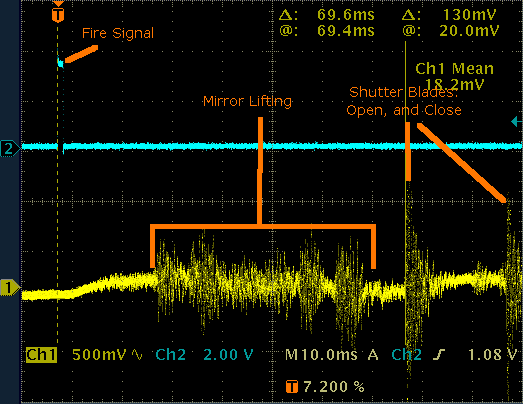Nikon D90 Shutter Timing Measurement
Introduction
I’ve been working on some electronics and software to do precisely timed photography setups for capturing water drops. One of the issues I encountered was that I seemed to have a lot of unpredictability in the delay between when I fired the shutter signal and when the shutter opened. I took some measurements to find out what range of shutter lag I needed to account for when calculating trigger times, and once I got setup it quickly became clear that there were two delay modes I was seeing: a short, very predictable delay, and a much longer and much more varied delay. It didn’t take much longer to realize what the difference was between these mode, and that this was what was causing my problems:
The D90 has a very predictable shutter lag when it is ready to go. When the display is still active showing the image from the previous shot, there is a much longer shutter lag, and it varies a lot. So, when precisely controlled timing is required, you need to make sure the display is off before triggering. This can be done by either waiting for the shooting info display to turn off, or half-pressing the shutter button. In my setup, I wired the half-press and full-press together, because I didn’t think I’d have any reason to command a half-press. In the future, I think I will wire them both to be controlled separately, so that part of the sequence can be to send the half-press command early enough to ready the camera before sending the full-press shutter command.
The Setup
I controlled the camera via the remote shutter cable input. I had both the half-press and full-press wires connected together, so that both were shorted at the same time to the common wire with a FET. I used a microphone to detect the shutter, and connected both the trigger signal and the audio signal from the microphone to an oscilloscope to measure the delay.
The Results
When the display was still on, the shutter delay was around 210 ms. It varied a lot. At least 20 ms, probably more, but to be honest once I figured out what was going on I didn’t really record measurements for this case.
When the display had turned off, the delay was 70.2ms, +/- 0.5ms.
The capture below shows the sequence. The camera was set for 1/5 shutter time, or 20ms. I’m fairly sure that the first long sound is the mirror opening, and then the is a quick sharp sound which is the first shutter blade opening, followed 20ms later by the second shutter blade following it to block the sensor. The time between these two pulses varies as it should with exposure time.

As you can see here, the bulk of the shutter delay appears to be taken by the mirror movement, which takes around 40ms. It is possible that there is something else going on that the camera would have to wait for anyway, but I have to wonder why they don’t have a mode to hold the mirror open to begin with. Even in live-view, where the mirror is normally up, the D90 closes the mirror when you press the shutter button, then opens it again to take the shot. I’ve no idea why they would do that.